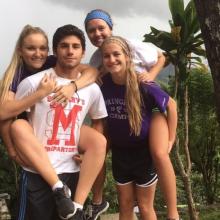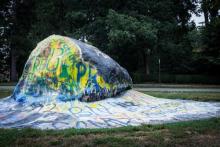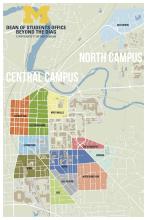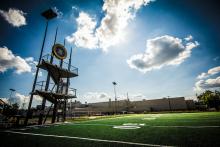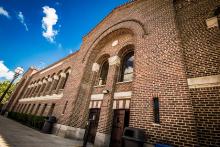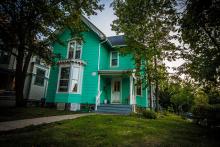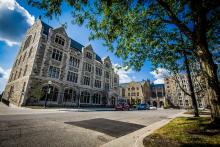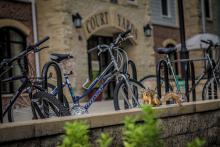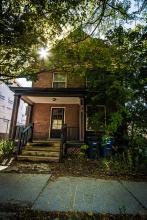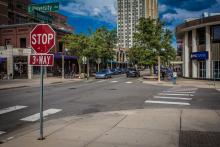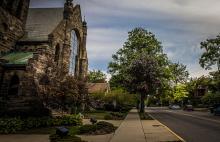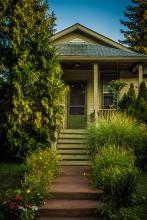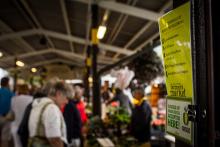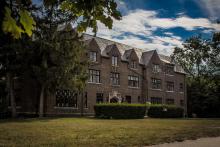As you start to get situated in your new home away from home, you might start wondering where exactly you're living. Not the address – the neighborhood! Inevitably, you're living in one of a dozen places that each have unique historical, cultural, and geographical contexts. Locate your neighborhood below to learn about what it has to offer!
The Old Fourth Ward Neighborhood Association (OFWA) welcomes you to downtown living!
One of the things that distinguishes downtown from other districts around campus is the neighborliness of residents. We take pride in our community and work hard together to make the downtown an attractive place to live, work, study and relax.
Get to Know Your Off-Campus Neighborhood
Everywhere you go around off-campus is different, some areas feeling more student oriented and others feeling historic and scenic. As you settle into your new homes, you may wonder what type of community you live in. Each of the off-campus neighborhoods highlight different historical, cultural, and geographical components. You can check out the off-campus map to find your neighborhood as well as those that surround you and discover what you can expect this year!
Elbel
Named after Michigan alum Louis Elbel – the composer of the “The Victors” – the Elbel Neighborhood is located just north of the Intramural Sports Building. Comprised almost entirely of student residents, the neighborhood is just a short walk from the Big House and the rest of the Athletic Campus. The Commuter South buses travel regularly down Hoover Street and provide convenient transportation for students going to/from their homes and classes. At the corner of Division Street and Hill Street, Elbel Field sits in the middle of the neighborhood.
Yost
South of Packard and east of State Street is the Yost Neighborhood, named after former football coach Fielding H. Yost, who led the Wolverines to their first national championship in 1901. A short walk from South Campus, the area is home to many student athletes and undergraduate students. Every 15-20 minutes, the free Wolverine Tower Shuttle (operated by The Ride) stops on State Street to bring Yost Neighborhood residents to and from Central Campus.
North Ingalls
Located directly north of Rackham Graduate School is the North Ingalls Neighborhood, which is almost entirely made up of student residences. The North Ingalls Building – home to the School of Nursing – sits in the center of the neighborhood amid unique and colorful houses. For convenient travel throughout campus, the Commuter North and the Diag-to-Diag Express buses make stops just outside the neighborhood on Fletcher Street and on the corner of Catherine St. and Glen Ave.
Tappan
Located in the center of the off-campus area is the Tappan Neighborhood. Named after Henry Philip Tappan – the first President of the University of Michigan – the neighborhood is home to many Greek houses and student residences. The area also includes two of the University’s most prominent landmarks: The Law Quad and the Ross School of Business. The East Quad Residence Hall, which houses the Residential College, hosts a series of original student performances throughout the year – most of which are free to students.
West Murfin
The West Murfin Neighborhood, which rests north of Hubbard Road, holds the distinction of being the sole student neighborhood on North Campus. Comprised mainly of student apartment buildings, West Murfin is immersed in nature and is located adjacent to the North Campus Recreation Building and Bursley Hall. Northwood Buses stop regularly on Murfin Avenue, providing convenient transportation to and from Central Campus. Just across the street, the University-run Northwood Undergraduate and Community Apartments house undergraduate students as well as many graduate students with families.
East Packard
The East Packard Neighborhood lies south of Oakland Street and is almost entirely comprised of student houses and apartments. At the heart of the neighborhood is the Tappan Triangle – a popular meeting place for residents and events. Around the Triangle you can find a series of new LED light fixtures – a pilot program through the City of Ann Arbor to improve lighting in off-campus student neighborhoods. Due to its large student populations, the East Packard Neighborhood provides some of the strongest communities off-campus.
South University
East of Church and south of Geddes rests the South University Neighborhood, primarily composed of Michigan undergrads. A mere 5-10 minute walk from the Central Campus Transit Center – the University’s primary bus stop – residents here are equally close to the Michigan campus and the vibrant Ann Arbor nightlife. To the east of the neighborhood lies the historical Forest Hill Cemetery. Founded by a group of Ann Arbor businessmen and professors in 1857, Forest Hill is one of the city’s most treasured landmarks.
Germantown
On the west side of campus, nestled between busy State and Main Streets rests Germantown – a neighborhood grounded in its historical ties to the city. Amid colorful, turn-of-the-century homes and towering tree lines, the stone walls and bell tower of the castle-like Bethlehem United Church rise high into the sky. Dedicated in 1896, the Gothic-style church was built by German members whose ancestors first settled in the area in the early 1800’s. Today, Germantown is home to both student and permanent residents, as well as University landmarks such as the Michigan Union and the Cube.
Old West Side
The Old West Side is a residential neighborhood bounded by Fifth Avenue to the east, Kingsley to the north, Seventh on the west, and William on the south. Home to many graduate students and permanent residents, this area includes a wide variety of homes dissimilar in age, building style, or type – many dating from 1850 to 1925. Amid the quiet, tree-lined streets, residents can grab a treat at popular gathering spots such as the Jefferson Market & Cakery and Washtenaw Dairy.
North Burns Park
South of Hill Street and East of Forest, North Burns Park is one of the oldest, most historic residential areas in Ann Arbor. When the city started to expand in the late 1800s, streetcars were constructed to carry North Burns Park residents from the racetrack on the south side of Ann Arbor into town. The area has been home to Professor’s Row – a large collection of University Faculty houses – for over a century.
Old Fourth Ward
The Old Fourth Ward Neighborhood lies within the Old Fourth Ward Historic District – one of the first residential areas in the city. The land was purchased by pioneer settlers and quickly became known as the center of Ann Arbor, inhabited by the town's leading citizens. Fondly remembered as many travelers’ first acquaintance to the City, visitors were transported by carriage up the steep hills of State Street into the city from the railroad station. Today, the Old Fourth Ward Neighborhood is home to Kerrytown, a lively marketplace blending the best of the old and new.
Oxbridge
The Oxbridge Neighborhood, serving student residents east of Washtenaw Avenue and south of South University, originally derived its name from its two central streets – Oxford and Cambridge Roads. Historically referred to as College Hill due to the Greek houses in the area, the Oxbridge Neighborhood hosts a number of sororities and fraternities in addition to the Oxford Housing residence hall.

